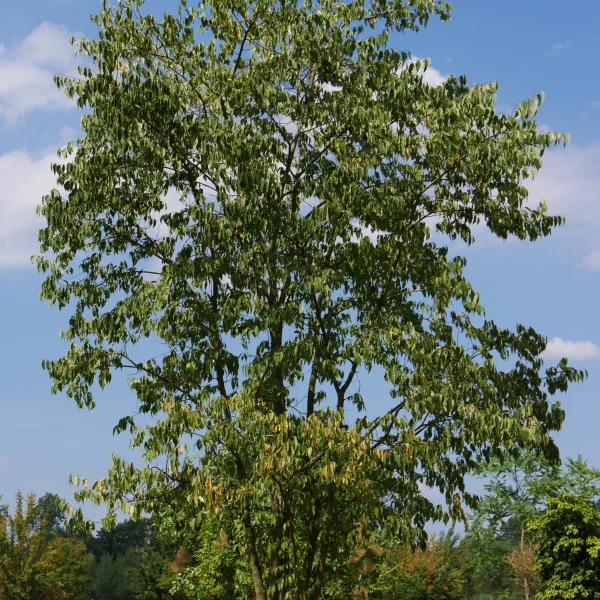Celtis occidentalis – North American hackberry, Nettle tree
Ulmaceae
Celtis occidentalis – North American hackberry, Nettle tree
Un copac cu o coroană de formă neregulată, originar din America de Nord. În câteva locuri, pot fi găsite exemplare care depășesc 20 m, uneori 30 m. Se ramifică destul de jos, formând uneori un arbore cu mai multe tulpini, cu multe crengi puternic căzute. Trunchiul este zimțat, cu crestături adânci și multe umflături. Frunzele sunt alungite ovoidale, cu vârful lung și de culoare verde lucios. Partea inferioară este mai mată. Jumătatea superioară a marginii frunzei este puternic zimțată și ambele fețe ale frunzei se simt aspre. Toamna, devine de un galben auriu izbitor. După o înflorire discretă, apar drupe mici, care se transformă de la portocaliu la negru-violet. Acestea pot rămâne pe copac toată iarna. Lemnul este valoros, iar crengile tinere, flexibile, erau folosite cândva ca biciuri.
Availability
Specifications
Download PDF
Height
8 - 15 (30) m
Width
6-12m
Crown
round, irregular , half-open crown, capricious growing
Bark and branches
grey, irregularly corky-winged
Leaf
ovate-lanceolate, green, 7 - 15 cm
Autumn colour
yellow
Flowers
inconspicuous, green, April/May
Fruits
round stone fruit, purple black, Ø circa 1 cm
Spines/thorns
None
Toxicity
usually not toxic to people, (large) pets and livestock
Soil type
few requirements
Soil moisture
suitable for dry soil
Paving
tolerates paving
Winter hardiness zone
4 (-34,4 to -28,9 °C)
Wind resistance
slightly susceptible
Other resistances
resistant to frost (WH 1 - 6)
Fauna tree
aluable for bees (honey plant), valuable for butterflies
Application
avenues and broad streets, industrial areas
Shape
clearstem tree, multi-stem treem
Origin
central and eastern part of North America
Possibly of interest
Frequently asked questions
Celtis occidentalis
Celtis occidentalis can eventually reach a height of 8 - 15 (30) m, depending on the site and climate conditions.
Celtis occidentalis has a average growing and can eventually reach a height of 8 - 15 (30) m, depending on the site and climate conditions.
The leaves of Celtis occidentalis turn yellow in autumn.
The right time to plant Celtis occidentalis is during the dormancy period. In Western Europe, Celtis occidentalis with root balls can generally be planted from mid-November to late April, although this depends strongly on the climatic conditions and the species of tree.
april.
General
 English
English
 English (United Kingdom)
English (United Kingdom)
 Nederlands
Nederlands
 Nederlands (België)
Nederlands (België)
 Deutsch
Deutsch
 français
français
 čeština
čeština
 polski
polski
 español
español
 română
română
 dansk
dansk
 svenska
svenska
 magyar
magyar
 Türkçe
Türkçe
 slovenčina
slovenčina
 русский
русский
 norsk
norsk











